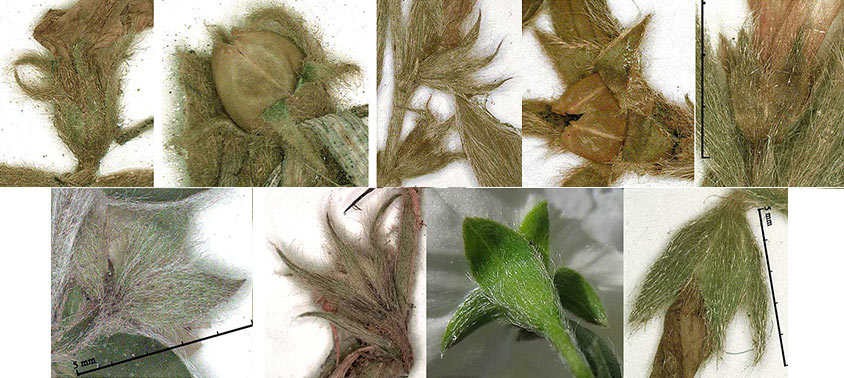
E. nuttallianus, E. arenarius & E. sericeus/E. discolor sepals. Click for page with larger images with identification.

Sepal differences have played a significant role in distinguishing E. sericeus/E. discolor and E. nuttallianus1, from Nuttall's 1818 description to the present. Pursh in publishing the new E. argenteus, 1816, does not describe the sepals, apparently relying on vestiture differences to distinguish these two taxa ("foliis oblongis utrinque sericeo-tomentosis" - leaves sericeo-tomentose on both sides). Shinners 1970 likewise makes no mention of sepals (beyond "sepals 5" for the genus) — an unfortunate decision, since he relies upon leaf pubescence as a key feature, but this is valid only east of the Trans–Pecos.
1Earlier synonyms E. argenteus (Pursh), E. pilosus (Nuttall).
| source | E. nuttallianus | E. sericeus |
|---|---|---|
| Current recognized authority | ||
| van Ooststroom 1934 | lanceolate or narrow-lanceolate | narrow-oblong-lanceolate to oblong-lanceolate |
| Early (19th century) investigators | ||
|---|---|---|
| Pursh 1816 | — | — |
| Nuttall 1818 | linear | ovate, acuminate |
| Don 1831-38 | partly linear, and acuminated | lanceolate, acute, with recurved tops |
| de Candolle 1845 | — | linari-lanceolatis 2 1/2 lin. longis acutis extus sericeis |
| Gray 1878 | lanceolate-subulate | ovate-lanceolate |
| Recent publications | ||
|---|---|---|
| Kearney & Peebles 1960 | linear or narrowly lanceolate | lanceolate or ovate lanceolate |
| Shinners 1970* | — | — |
| Martin & Hutchins 1981 | linear to linear-lanceolate | lanceolate to ovate-lanceolate |
| Austin 1998 | lanceolate to narrow-lanceolate, 4–5 mm long, spreading villous | oblong-lanceolate, 3–5 mm long; appressed-pilose |
| Diggs 1999** | lanceolate to narrowly lanceolate, 4–5 mm long, spreading pilose | oblong lanceolate, 3–5 mm long, appressed pilose |
|
*In Correll & Johnston 1970.
**for N. Central Texas (obviously based on work by Austin) |
||
An attempt to apply the features of more recent taxonomists in the above table to the nine images at the top of this page (or better, on the page with their larger images) will produce neither uniform results nor the desired results. In part, the terms seem to leave open potential overlap (i.e., determining the boundaries between linear-lanceolate, narrowly lanceolate, lanceolate, oblong-lanceolate, ovate-lanceolate). And in part because at the eastern edge of its range E. nuttallianus has rather broad sepals, close to ovate with an acuminate apex (e.g., in Fannin Co., Hays Co., Travis Co.). Yet a third consideration comes into play when vestiture–based determinations incorrectly classify plants of the Trans–Pecos and adjacent Mexico with broad–based sepals, i.e., E. discolor & E. arenarius, as E. nuttallianus.